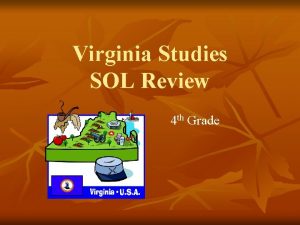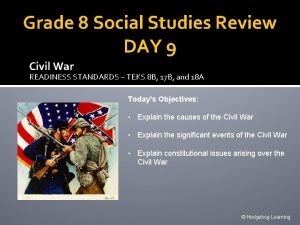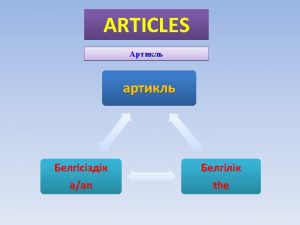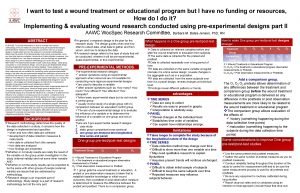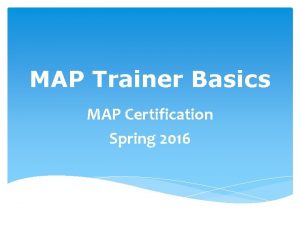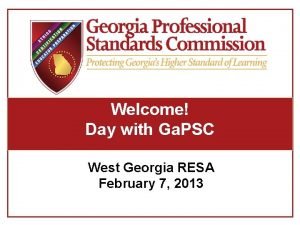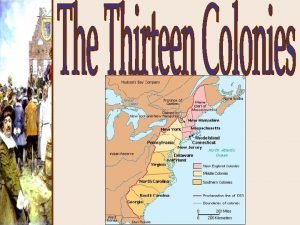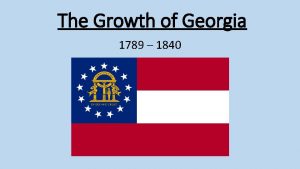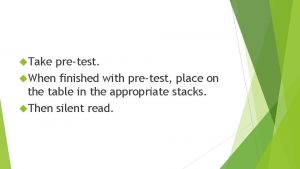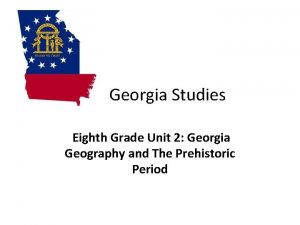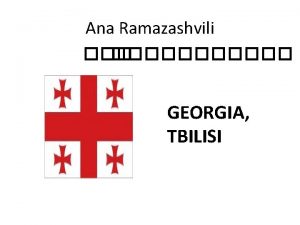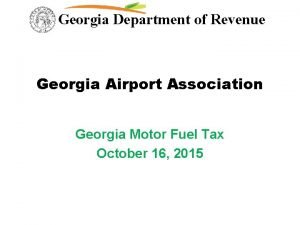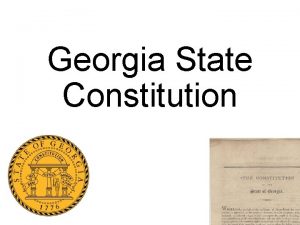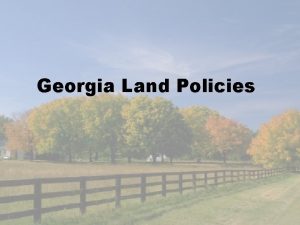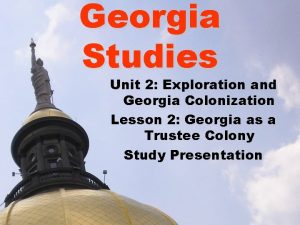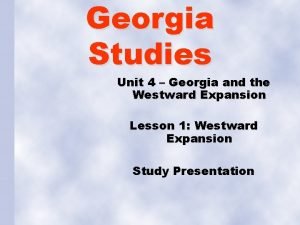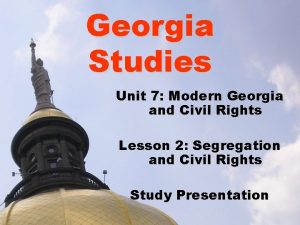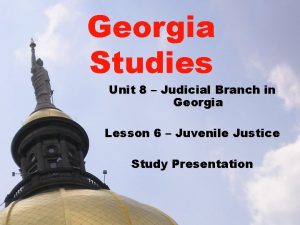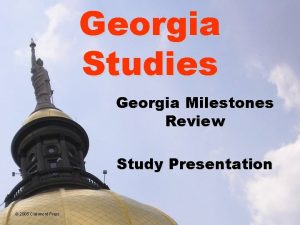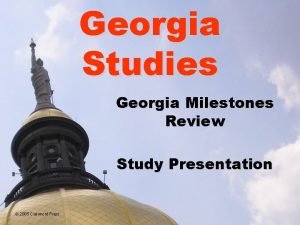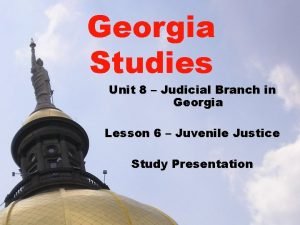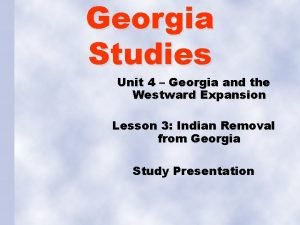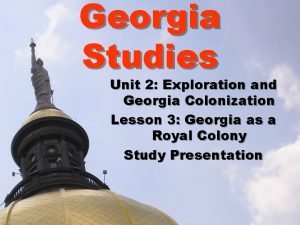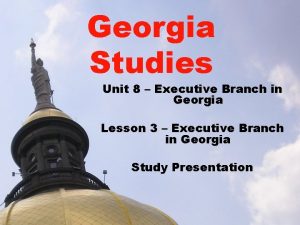Georgia Studies PreTest 1 Take PreTest 2 Grade































































- Slides: 63

Georgia Studies Pre-Test 1. Take Pre-Test 2. Grade your own Pre-Test Answer sheets are located on the front table 3. Answer the question at the bottom of your answer sheet 4. Turn in under TV 5. Wait for everyone to finish so we can talk about the field trip!

5 Regions of Georgia Due Tuesday at the end of class

Geography

Geography: the science of studying earth as the home of humans.

Geography Identify: This allows us to understand ourselves, the places that we live, our relationships with the environment and our interdependence on other areas of the world.

Geography Cars: Route 66

Geography Relative Location: Describes where a place is compared with other places So what is Georgia’s relative location?

Geography Why is relative location important? Describes weather patterns, gives us a general location and allows us to look at the big picture

Geography Absolute Location: Identifies a precise position on Earth’s surface’ often stated in longitude and latitude What is Georgia’s absolute location?

Geography Hemispheres: One half of a sphere Which hemisphere is Georgia located in?

Geography

Geography North Western

Geography Parallels: An imaginary line that runs east and west side-by-side with the equator Latitude: A measure of the distance north or south of the equator; expressed in degrees, minutes & seconds

Geography

Geography Meridians: A line that runs north and south from one pole to the other Longitude: A measure of the distance east or west of the prime meridian; expressed in degrees, minutes, and seconds

Geography Region: An area of Earth’s surface that is defined by certain unifying characteristics


Geography Barrier Island: An island that lies off the coast and protects the beaches by blocking much of the wind, sands, and water that could erode the mainland

Georgia’s Climate

Climate v. Weather Climate refers to the type of weather a region experiences over a long period of time. Weather refers to the day-to-day conditions and changes in the atmosphere

Temperature Georgia’s temperature is mild compared to other states Northern Georgia climate is slightly different because of its mountainous features.

Vertical climate: is when temperatures are lower because of the higher elevation

Precipitation Average rainfall in Georgia: • 40 -52 in. in central & south GA • 65 -76 in. in the mountains • Wettest month = July • Driest month = October

Precipitation Blue Ridge Mountains provide precipitation for the whole state by preventing humidity to cross over them

Drought Combined with the rain that we already receive, the snow from the north Georgia mountains melts and runs off into our rivers and lakes providing water for our crops. When we have a shortage of rainfall, Georgia’s economy is dramatically effected. Not only are we in danger of loosing our crops, but water related recreational activities also become more difficult.

Do you have any questions about Georgia’s Climate?

Questions 1. How does Georgia’s latitude and longitude affect our climate? 2. Why is precipitation so important to Georgia’s economy? 3. How does the Gulf of Mexico affect Georgia’s climate?

The Five Regions of Georgia


Appalachian Plateau • Limestone caves & canyons • Nicknames: • “TAG” Corner: Tennessee, Alabama & Georgia • Cumberland Plateau • Lookout & Sand Mountain • Soil composition: • limestone, shale & sandstone • Hardwood Forests • Battle of Chickamauga


Ridge & Valley • Made up of ridges & valleys • Soil Composition: • Shale & limestone • Resistant to erosion • Mostly forests & pastures • Taylor Ridge & Pigeon Mountain • Dalton, GA: “the carpet capitol of the world!”


Blue Ridge Region • Provides precipitation for the entire state • Sandy Loam soil: mixture of clay, sand & organic matter • Brasstown Bald: 5, 000 feet • Springer Mountain: beginning of Appalachian Trail • Amicolola Falls • Tallulah Gorge • Helen


Piedmont • “foot of the mountain” • Made of rolling hills and flat plains • Granite, Sandy Loam & GA red clay • ½ population

Fall Line This is an imaginary line that separates the Piedmont from the Coastal Plain Columbus Macon Augusta Fuller’s Earth is mined along the Fall Line, which is the mineral used in Kitty Litter


Coastal Plain • 3/5 State • Inner Coastal: mild climate with good supply of underground water • Outer Coastal: wetlands & barrier islands

Marble

Georgia's Transportation Systems

Essential Question How have Georgia’s transportation systems (air, land, water, railroads) changed over time and affected human activity and economic opportunities?

WATER

Georgia’s waterways provided transportation and food for early Indian tribes. When European settlers arrived, they set up trading posts and established temporary and permanent settlement sites on river bluffs (steep riverbanks).

Why would early people chose to live near water?

For about 100 years after its founding, Georgia generally used transportation routes first established by Native Americans.

Why?

Atlantic Ocean • Georgia has more than 100 miles of coastline • Begins at the Savannah River and goes to the St. Mary’s River

Georgia’s waterways serve as important inland “highways” for social, political, and economic growth.

Why?

DEEPWATER PORTS Savannah & Brunswick

LAND

Georgia Highways Odd Even

From Georgia, goods are two truckload days from 82 % of the United States industrial marketplace and 79 % of the nation’s largest consumer markets.

• Over 100 motor freight carriers serve the metropolitan areas of Georgia. • The state has 35 scheduled carriers, 2, 200 intrastate haulers, and 25, 000 interstate truckers serving the state.

RAILROADS

Georgia’s two major railroad lines: 1. CSX 2. Norfolk Southern


AIR

• In 1926, the first air mail service in the region began from Chandler Field. • In 1929, Delta Air Lines began passenger service between Atlanta and Dallas. • In 1930, Eastern Air Lines began serving Atlanta.

• the city of Atlanta bought Candler Field in 1930 and began building hangers and lengthening runways. The rest is history. . .

Hartsfield-Jackson Atlanta International Airport, named former Atlanta mayors William B. Hartsfield and Maynard Jackson, has a main terminal, six concourses, and nearly 200 gates.

Hartsfield-Jackson Atlanta International Airport • one of the busiest passenger airports in the world. • In an average weekday afternoon, 500 aircraft may be in the air flying toward Hartsfield-Jackson, and an equal number may be in the air after departing it. • In an average month, about 80, 000 flights and more than 7 million passengers pass through the airport on flights scheduled with 21 airlines. • At the same time, the airport will handle about 53, 700 metric tons of cargo and more than 60, 000 metric tons of mail on airliners and cargo aircraft operated by 20 companies.
 Brain wrinkles georgia studies
Brain wrinkles georgia studies Paradigm shift from women studies to gender studies
Paradigm shift from women studies to gender studies Take a bus or take a train
Take a bus or take a train Georgia tech grade inflation
Georgia tech grade inflation Georgia standards of excellence ela
Georgia standards of excellence ela Elagse
Elagse Georgia habitats 3rd grade project
Georgia habitats 3rd grade project Elagse
Elagse Meaning of living together in social studies
Meaning of living together in social studies Virginia studies 4th grade
Virginia studies 4th grade History grade 9 unit 5
History grade 9 unit 5 Our worldviews grade 8 textbook
Our worldviews grade 8 textbook Day 10 grade 8 social studies staar review
Day 10 grade 8 social studies staar review Continuous statistics
Continuous statistics Chapter 3 social studies grade 9
Chapter 3 social studies grade 9 Social studies chapter 2
Social studies chapter 2 6th grade social studies ancient israelites
6th grade social studies ancient israelites A student's grade depends on how much she studies
A student's grade depends on how much she studies He studies english
He studies english Grade 7 social studies empowerment
Grade 7 social studies empowerment 8th grade social studies
8th grade social studies Business studies grade 11 2020 term 2 sba task presentation
Business studies grade 11 2020 term 2 sba task presentation A student's grade depends on how much she studies
A student's grade depends on how much she studies 4th grade social studies vocabulary
4th grade social studies vocabulary Pretest: developing an academic and career plan
Pretest: developing an academic and career plan The early and mid-nineteenth century romanticism
The early and mid-nineteenth century romanticism Injectable medication administration pretest
Injectable medication administration pretest Intravenous medication administration pretest
Intravenous medication administration pretest Pretest growth development and sexuality
Pretest growth development and sexuality Pretest publicitario
Pretest publicitario Pretest communism and the cold war
Pretest communism and the cold war Proxy pretest design
Proxy pretest design Pepp pretest
Pepp pretest Proxy pretest design
Proxy pretest design Pretest loop c++
Pretest loop c++ Art pretest
Art pretest Pretest: the universe
Pretest: the universe Topic sentence test
Topic sentence test Identify the part of speech
Identify the part of speech Alejandro rodriguez vilela
Alejandro rodriguez vilela Wound care pretest
Wound care pretest Zero slope graph
Zero slope graph Hdmaster map ma
Hdmaster map ma Deped transmutation table
Deped transmutation table Teddy bear jump rope rhyme
Teddy bear jump rope rhyme Difference between grade a and grade aa eggs
Difference between grade a and grade aa eggs Grade a milk vs grade b
Grade a milk vs grade b Grade grade
Grade grade Meta - change morph
Meta - change morph Success academy georgia state
Success academy georgia state Who founded georgia
Who founded georgia 5 regions of georgia
5 regions of georgia Georgia constitution
Georgia constitution Metro resa leadership certification
Metro resa leadership certification North carolina marschland
North carolina marschland Venture lab georgia tech
Venture lab georgia tech Transitional housing for offender reentry
Transitional housing for offender reentry Tiffany taylor georgia department of education
Tiffany taylor georgia department of education Hipaa training georgia
Hipaa training georgia Georgia relative location
Georgia relative location Capitals of georgia
Capitals of georgia Wic approved formula ga
Wic approved formula ga Ga qso party
Ga qso party Ga coam
Ga coam









